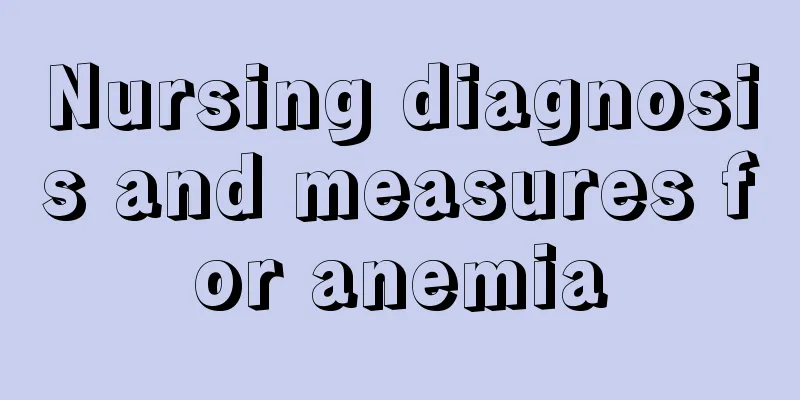Nursing diagnosis and measures for anemia

|
The main substances that make up human blood are red blood cells, white blood cells, platelets and other substances, but no matter which substance is missing, it may cause blood diseases. Anemia mainly refers to the fact that there are fewer red blood cells in a person's blood, so if a person is malnourished or iron deficient, it will cause anemia. So if a person has anemia, how should he be cared for and what are the measures? 1. Diagnosis of anemia During the examination, special attention should be paid to: ① fever, heart rate, and respiratory rate; ② the presence of malnutrition, special facial features, orthopnea, unsteady gait, etc.; ③ the presence of paleness, jaundice, ulcers, petechiae, purpura, or ecchymosis on the skin and mucous membranes; the presence of dry hair, atrophy of the lingual papillae, spoon-shaped nails, pitting edema in the lower limbs, etc.; ④ the presence of enlarged lymph nodes; ⑤ the presence of enlarged cardiac borders, murmurs, etc.; ⑥ the presence of hepatomegaly, splenomegaly, or biliary inflammation; ⑦ the presence of neuropathic reflexes and deep sensory disorders, etc. Nursing for anemia 1. In serious cases, you should stay in bed and limit your activities. Avoid fainting after sudden changes in body position and pay attention to safety. 2. Oxygen should be given when anemia is accompanied by palpitations and shortness of breath. 3. Provide high-calorie, high-protein, and high-vitamin foods, such as lean meat, pork liver, beans, fresh vegetables, etc. Pay attention to the color, aroma and cooking to promote appetite. 4. Observe the symptoms of anemia such as the paleness of the complexion, conjunctiva, lips, and nail beds; pay attention to the presence of central hypoxia symptoms such as dizziness, tinnitus, and drowsiness; pay attention to the presence of symptoms of anemic heart disease such as palpitations, shortness of breath, and precordial pain. 5. During blood transfusion, the nursing staff should check carefully and observe the transfusion reaction closely. When transfusing blood to patients with severe anemia, the transfusion speed should be slow to avoid inducing heart failure. 3. Treatment of anemia Usually, anemia is just a symptom, not a single disease. Therefore, the underlying cause needs to be determined before effective treatment can be carried out. Patients with acute massive blood loss should actively stop bleeding, while quickly restoring blood volume and transfusing red blood cells to correct anemia. Nutritional anemia can be treated by supplementing the missing nutrients, such as iron supplementation for iron deficiency anemia and treatment of the primary disease that causes iron deficiency; and folic acid or vitamin B12 supplementation for megaloblastic anemia. The treatment of non-nutritional anemia is more complicated. Autoimmune hemolytic anemia is mainly treated with immunosuppressants such as glucocorticoids. Chronic aplastic anemia is mainly treated with cyclosporine combined with androgens. For example, inherited anemias such as Fanconi anemia can be treated with hematopoietic stem cell transplantation. |
<<: What to do if the baby's hip bones are asymmetrical
>>: Hypothalamic Pituitary Thyroid Axis
Recommend
What should I do if clothes turn yellow after being stored for a long time
In daily life, many people hate to wash white clo...
Things to note during the urine-stimulating injection
Many patients have difficulty urinating due to pr...
What can I eat to get diarrhea quickly
We know a lot about how to stop diarrhea quickly,...
What are the three major treatments for neuralgic headaches
Neuralgic headaches are particularly harmful to p...
What is the reason for slight numbness on the face
If there is anything abnormal in our body in our ...
What are the taboos of cutting hair during confinement
I believe that many beautiful women who have just...
How to clean the moxibustion cup better
Moxibustion is a very healthy way of health prese...
What are the specific manifestations of the harmful effects of gastric cancer?
Cancer is very common in life, and there are many...
Is mucosal melanoma related to light exposure? Will malignant melanoma metastasize to distant sites?
Melanoma is a highly malignant tumor with an inci...
What are the side effects of washing your hair with white vinegar?
White vinegar is not unfamiliar to each of us. In...
Difference between sarcoma and osteosarcoma
The main difference between sarcoma and osteosarc...
Is long-term oily skin caused by lack of water? How to deal with it?
Skin is a part that people pay more attention to,...
Scrape test can help high-risk groups screen for cervical cancer
Cervical smear cytology was proposed by an Americ...
Is cross-eyed strabismus?
Many people are very concerned about some changes...
What if there is a lump in the breast that doesn't hurt?
I believe that many women have had lumps in their...









